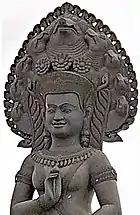Queen Soma
Soma(Khmer: នាង នាគី សោមា, Somā)[1] [2]was the ruler of the Kingdom of Funan and widely claimed as the first monarch of Cambodia (reigned c. 1st century).[3] She was also the first female leader of Cambodia.[4] She was the consort of Kaundinya I (also known as "Huntien" and "Preah Thong"). She is known as Soma (Indian), Liǔyè (柳葉, Chinese), Liễu Diệp (柳葉, Vietnamese) and Neang Neakii (នាង នាគី Khmer).[5]
| Soma | |||||
|---|---|---|---|---|---|
| 1st Monarch of Cambodia | |||||
 | |||||
| Queen of Funan | |||||
| Reign | 1st century CE | ||||
| Coronation | 68 CE | ||||
| Predecessor | Inaugural holder | ||||
| Successor | Kaundinya I | ||||
| Born | Funan | ||||
| Spouse | Kaundinya I | ||||
| |||||
| House | House of Kaundinya | ||||
| Religion | Khmer Animism, Hinduism | ||||
Life
Queen Soma and her husband, Kaundinya I, are known in Khmer legend as "Preah Thong (Kaundinya) and Neang Neak (Soma)". According to reports by two Chinese envoys, Kang Tai and Zhu Ying, the state of Funan was established by an Indian Brahmin merchant from ancient Kalinga named Kaundinya.[6][7]
Legendary account
As per the legends, an Indian merchant ship was attacked by the pirates led by Soma, daughter of the chieftain of the local Nāga clan. The merchants led by Kaundinya fought back and fended off the attackers but the ship had been damaged and was beached for repairs. The Indians were wary of a second attack but Princess Soma was impressed by Kaundinya's bravery and proposed marriage which was accepted. The union led to the foundation of the House that became the royal dynasty of Funan which would rule the region for many generations and the royal legitimacy was also acquired through the female line in the kingdom. This also explains the reason why the serpent (Nāga) became an important part of Khmer iconography as is seen a thousand years later when this historic mystical union remained an important part of the court ceremonies at Angkor during the era of the Khmer Empire.[8][9][10]
Modern theories
Newly discovered DNA evidence, suggest there is some truth to the Khmer creation mythology. DNA sample taken from a protohistoric individual from the Wat Komnou cemetery at the Angkor Borei site in Cambodia contains substantial level of South Asian admixture (ca. 40–50%). Radiocarbon dating result on the human bone (95% confidence interval is 78–234 calCE) indicate that this individual lived during the early period of Funan.[11]
References
- "SEAlang Dictionary". www.sealang.net. Retrieved 2023-10-14.
- "SEAlang Dictionary". www.sealang.net. Retrieved 2023-10-14.
- "The women who made Cambodia". The Phnom Penh Post. 19 May 2010.
- "C. 87 Stela from Mỹ Sơn B6". Corpus of the Inscriptions of Campā.
- Pelliot, Paul (1903). "Le Fou-nan". Bulletin de l'École française d'Extrême-Orient (in French). 3: 248–303. doi:10.3406/befeo.1903.1216. Retrieved 12 April 2021.
- Coedès, George (1968). Walter F. Vella (ed.). The Indianized States of Southeast Asia. trans.Susan Brown Cowing. University of Hawaii Press. ISBN 978-0-8248-0368-1.
- Chad Raymond (2005), "Regional Geographic Influence on Two Khmer Polities", Journal of Third World Studies, University Press of Florida, 22 (1): 135–150, JSTOR 45194224, retrieved 31 March 2021
- Sanyal, Sanjeev (2016-08-10). The Ocean of Churn: How the Indian Ocean Shaped Human History. Penguin UK. p. 82-84. ISBN 978-93-86057-61-7.
- Tarling, Nicholas (March 2008). The Cambridge History of Southeast Asia. Cambridge University Press. ISBN 9781139055482.
- Hall, DGE (14 May 1981). History of South East Asia. Macmillan Education UK. ISBN 9780333241646.
- Changmai, Piya; Pinhasi, Ron; Pietrusewsky, Michael; Stark, Miriam T.; Ikehara-Quebral, Rona Michi; Reich, David; Flegontov, Pavel (2022-12-29). "Ancient DNA from Protohistoric Period Cambodia indicates that South Asians admixed with local populations as early as 1st–3rd centuries CE". Scientific Reports. 12 (1): 22507. doi:10.1038/s41598-022-26799-3. ISSN 2045-2322.